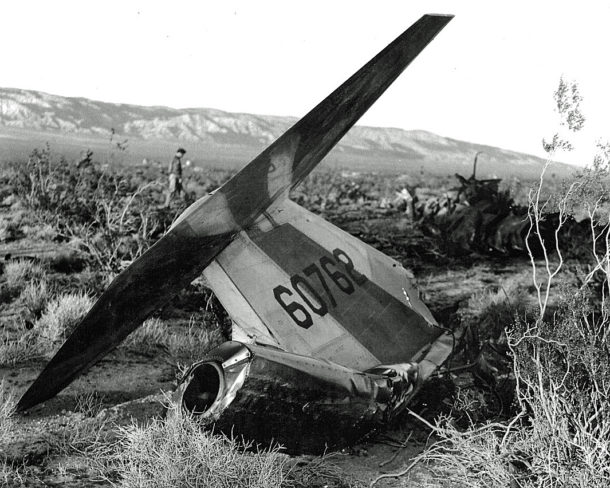
Fifty-six years ago to the day, USAF NF-104A (S/N 56-762; Ship 3) crashed to destruction following a rocket-powered zoom to 101,600 feet above mean sea level (AMSL). The pilot, USAF Colonel Charles E. “Chuck” Yeager, was seriously injured, but survived when he successfully ejected from the stricken aircraft approximately 5,000 feet above ground level (AGL).
The USAF/Lockheed NF-104A was designed to provide spaceflight-like training experience for test pilots attending the Aerospace Research Pilot School (ARPS) at Edwards Air Force Base, California. The type was a modification of the basic F-104A Starfighter aircraft. Three copies of the NF-104A were produced (S/N’s 56-0756, 56-0760 and 56-0762). It was the ultimate zoom flight platform.
In addition to a stock General Electric J79-GE-3 turbojet, the NF-104A was powered by a Rocketdyne LR121-NA-1 rocket motor. The J79 generated 15,000 pounds of thrust in afterburner and burned JP-4. The LR-121 produced 6,000 pounds of thrust and burned a combination of JP-4 and 90% hydrogen peroxide. Rocket motor burn time was on the order of 90 seconds.
Around 1400 hours PST on Tuesday, 10 December 1963, Colonel Yeager took-off from Edwards Air Force Base to attempt his second zoom flight of the day. That morning, he had zoomed NF-104A, S/N 56-760 to an altitude of 108,700 feet. Four days earlier, Yeager had zoomed the same airplane to the highest altitude he would ever achieve in the type; 110,500 feet AMSL.
The zoom apex altitude for the ill-fated afternoon flight was only 101,600 feet AMSL with rocket motor burnout taking place 5 seconds post-apogee. That is, the aircraft was already on the descending leg of the zoom trajectory and in the early stages of reentry. Yeager later reported that the aircraft angle-of-attack at that point was on the order of 50 deg; a figure that is well past the NF-104A pitch-up angle-of-attack (i.e., 14-17 deg). Yeager had flown the aircraft this way on previous zoom flights and had always been able to lower the nose via reaction control system (RCS) inputs.
Unfortunately, the RCS did not not have sufficient pitch control authority to bring the nose down on the mishap flight. As a result, the aircraft began the reentry in an extremely nose-high attitude. As the dynamic pressure rapidly built-up, the NF-104A departed controlled flight and went through a series of post-stall gyrations between 90,000 and 65,000 feet. These gyrations ultimately led to a series of flat spins occurring between 65,000 and 20,000 feet.
Running out of altitude, Yeager desperately deployed his drag parachute as an anti-spin device. This action indeed stopped the flat spin. Airspeed picked-up to 180 KIAS with the aircraft hanging in the chute, but the pilot was unable to get an air-start on his J79 turbojet which had spooled down to 6% of maximum RPM. At 12,000 feet, Yeager jettisoned his drag chute and the NF-104A immediately pitched-up again into a flat spin. After three-quarters of a turn, Yeager ejected about 5,000 feet AGL. Yeager landed close to where the mishap aircraft had impacted and was in a great deal of pain due to burns he received during the ejection process. Happily, he survived this traumatic event and recovered completely from his injuries.
Objective analysis of the loss of NF-104A, S/N 56-762 reveals that the aircraft simply was not flown in a manner commensurate with the intricacies of the zoom environment. The critical importance of quickly intercepting and maintaining the target inertial pitch angle during pull-up had been repeatedly demonstrated by other test pilots as had proper control of aircraft angle-of-attack during reentry. Colonel Yeager elected not to fly the aircraft in accordance with these dictates.
In all of his NF-104A zoom attempts, Colonel Yeager consistently flew the airplane over the top at angles-of-attack well beyond the pitch-up value. RCS control authority was sufficient to lower the nose to sub-pitch-up angles-of-attack just prior to reentry on all but the mishap flight. Unfortunately, the low apex altitude (101,600 feet AMSL) of that zoom resulted in a higher dynamic pressure that, in conjunction with very high angles-of-attack, produced a nose-up aerodynamic pitching moment that the RCS could not overcome.
The aircraft mishap of 10 December 1963 forever changed the way in which NF-104A pilots would be allowed to fly the rocket-powered zoom mission. Prior to the mishap, the NF-104A had been zoomed to an altitude of 120,800 feet AMSL by USAF Major Robert W. Smith on 06 December 1963. This unofficial United States record still stands today. After a mishap investigation, NF-104A maximum altitude was limited to 108,000 feet AMSL. This restricted performance was mandated ostensibly out of concern for the safety of ARPS student test pilots.
The ultimate and lasting result of the post-mishap restriction on NF-104A flight performance was that it did a great disservice to ARPS student test pilots in that it made their spaceflight training experience something less than what it could and should have been. It is ironic that, although the correct manner in which to zoom the airplane had been repeatedly validated by USAF and Lockheed test pilots prior to the 56-0762 mishap, the decision to restrict NF-104A performance was based on a single flight which clearly demonstrated how not to fly the airplane.

